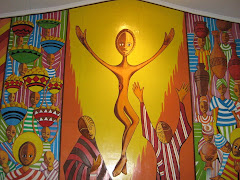(Synagogue - Toronto - Canada)
A Study Visit to Singers Hill Synagogue
By Victor Edwin SJ
victoredwinsj@gmail.com
Fr. Victor Edwin SJ is an Indian Jesuit
presently doing his doctorate in Islamic Studies
in Birmingham University (UK).
'''''''''''''''''''''''''''''''''''''''''''''''''''''''''''''''''''''''''''''''''''''''''''''''
"The diversity of religions has to be respected, since they are expressions of the self-disclosure of the One divine reality that always remains incomprehensible. Each believer has therefore to discover how the Divine manifests in his/her religious heritage and share this with others. This dialogical process is the dynamics of the spiritual reality that Jesus called the kingdom of God." (Prof Michael Amaladoss SJ)
The school of Theology and Religion (Birmingham University) offers a course on Introduction to Jewish Religion and culture to the undergraduate students. Professor Jonathan Webber, the Director of Jewish Studies in the School offers this module. The course module includes a study visit to Singers Hill Synagogue in Birmingham. I often meet Prof Webber on various occasions to discuss issues connected with dialogue between religions. He extended an invitation to join the undergraduate students for the Study Visit to Singers Hill synagogue. I gladly accepted his invitation.
It was the first time I ever visited a synagogue. At very the outset Prof Webber said: ''the concept of Synagogue is not mentioned in the Torah; it derives from the experience of exile. Synagogues are principally places of worship, but are also a place where the Jewish community often meet to listen to one another.''
The synagogue, he said, '' is a place of assembly, where Jews meet and recall the rituals which used to be held in Jerusalem. Theologically the synagogue is understood as the 'gate of heaven' where God and humanity can encounter each other. Architectural elements of the synagogue have been attributed with spiritual meanings of various kinds, as the abode of the divine presence as well as the spiritual loss brought on by exile.''
When Jews were on exile they could not perform the sacrifices they used to perform when they were in Jerusalem. Though they could not perform sacrifices they made it a point to read and remember the sacrifices. This is how prayer and study replaced sacrifice as the central rituals of Judaism in exile.
The focal point of the synagogue is the Aron Hakodesh (Sacred Ark), where the Torah scrolls are stored. The scrolls are kept in decorated box on an elevated platform with a decorative curtain upon it. A catholic Christian can easily visualise this: the Scrolls are kept like the way the Sacred Species is preserved in a Catholic Church. The Aron Hakodesh is the sanctum sanctorum of a synagogue.
The Torah is read aloud on the Sabbaths, festival days, fast days, and twice a week on ordinary week days. The Scrolls are still handwritten, must be complete, with each letter perfect, in order to be ritually valid. Along with his explanations, Prof Webber respectfully brought down the Scrolls for us. He kept the Scrolls on Bimah, the platform on which the scroll is opened and ceremoniously read, and read for us the portions that deal with the Ten Commandments. Reading ceremoniously is to chant the verses from the Scrolls. I touched the Scrolls. It was a great experience to touch and to listen from the Scrolls.
One of my favourite passages in the Christian Scriptures is from the Gospel of Luke (Chapter 4, 16-20). It reads:
[Then he came to Nazareth where he had been brought up and, according to his custom, went to the synagogue on the Sabbath day. He stood up to read the scriptures and the book of the prophet Isaiah was handed to him. He opened the book and found the place where these words are written - 'The Spirit of the Lord is upon me, because he has anointed me to preach the Gospel to the poor. He has sent me to heal the brokenhearted, to preach deliverance to the captives and recovery of sight to the blind, to set at liberty those who are oppressed, to preach the acceptable year of the Lord". Then he shut the book, handed it back to the attendant and resumed his seat. Every eye in the synagogue was fixed upon him and he began to tell them, "This very day this scripture has been fulfilled, while you were listening to it!" ]
Jesus read the Sacred Scriptures and preached in synagogues. The Gospels have many references to this effect. First time making a visit and listening to the sacred chanting made me realize that it is important for Christians to understand and cherish Jewish faith.
Above the ark is a ner tamid (eternal light), symbolising the presence of the Torah Scrolls in the building. Light in the Sanctum Sanctorum is a common sight in Catholic Churches and in Hindu temples. Light reminds of the sacred presence of God in a particular place. It reminds the worshiper that s/he is standing in the presence of God.
A few other things which reminded me of both Churches and Mosque are inscriptions, book cases, prayer shawls, and clock. In a Mosque you can find inscriptions from the Holy Qur'an and in the Churches one can find inscriptions from the Holy Bible. In the synagogues the inscriptions are from the Torah. I have seen in mosques, in India, the prayer timings written on a blackboard with chalks. A clock would be always there to remind the imam to begin prayers at proper time. Book cases are a common sight both in mosques and in Churches. The prayer books, hymn books, copies of bibles could be seen in the churches. While in the mosque, which often functions as a religious school for children would have books on Islamic instructions (talimul islam), the prayer books in the synagogues are printed editions of the Torah, as well as Talmudic literature used for study. Though Muslims do not wear any specific prayer shawl when he/she offers namaz, the Jewish men wear prayer shawls. Christian priests who celebrate the liturgy wear special costume which is called vestments.
The mechitsah is a physical division between men and women. Mechitsah can take different architectural forms, according to the needs and size of the congregation. Every synagogue would have three doors and a lobby. The lobby remains a meeting place for the congregation. The lobby at Singers Hill has some interesting English-language inscriptions demonstrating the relatively modern orientation of the congregation and its civic and national pride.
Prof Webber explained Jewish liturgy as reading a complex set of texts. The Jews praise God who created the world and who guide their day to day lives, recall their history, not only as historical events but as processes which are relevant in every day life. In their liturgy Jews ask god to help the individual and the community and to encourage the individual to lead a more moral life. They dream about the ideal life of the Bible and to try to rise above the meaninglessness of being in diaspora. It is very difficult to understand the pain of being in diaspora after holocaust. Praising God, recalling their history and asking God's help...etc are very familiar to the people of other religious faith too. The wounded memory of the holocaust is beyond the comprehension of the followers of other faiths. Webber's explanation of Jewish liturgy opened my eyes to their lives and struggles. I never felt that in such depth as I did on this day sitting in a synagogue. The language has the whole burden of retelling, recreating and re-enacting spiritual truth and making it relevant and meaningful. Here is a lot of word-play and other mystical ideas about language embedded in the liturgy. It was a fruitful day for me, thanks to Webber for his invitation.
:::::::::::::::::::::::::::::::::::::::::::::::::::::
Thank you Fr. Victor Edwin for your insightful sharing on your inter-religious experience.
................................................................












